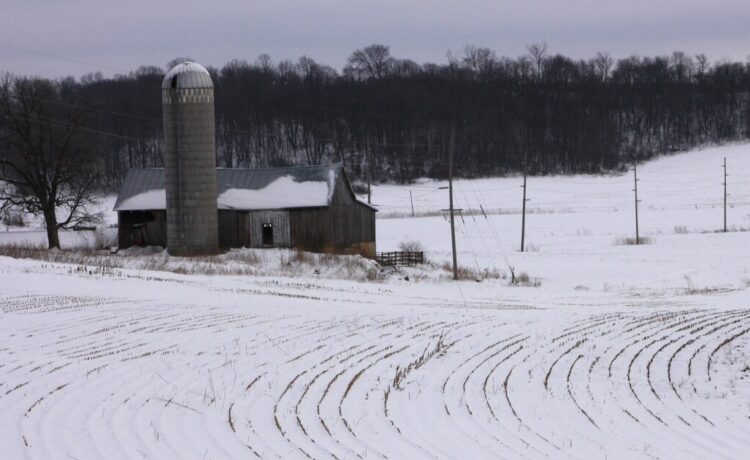Kevin Burres farms around 1,700 acres in Wright County. Seven years ago, he started planting cereal rye as a cover crop in his corn-soybean rotation. Burres said this conservation practice “works wonders” for reducing soil erosion, but it’s been small-scale.
Last year, he signed up for a project supported by the U.S. Department of Agriculture that pays farmers a premium for planting up to 500 acres of cover crops. Burres said he covered the upfront costs, expecting to be reimbursed in mid-January.
But he’s still waiting for that payment.
“So that left us out here with a bill for $16,000-17,000 that we cannot recoup,” Burres said.
Other farmers, as well as organizations that rely on USDA grants to pay staff, have reported similar delays. The American Soybean Association, National Sustainable Agriculture Coalition and other groups are urging the new administration to honor legally binding contracts.
Burres believes the USDA will pay what it’s promised to farmers. But it’s not clear how long that could take.
“Everything in rural America gets put on hold or slow-mode because we don’t account for much population out here, and that’s kind of disappointing because we are supposed to feed the world,” Burres said.
Shortly after President Donald Trump took office in January, he issued several executive orders aimed at reversing Biden administration policies.
“At least a couple of those executive orders really are creating deep ramifications for people across the country, including farmers [and] the communities in which they live,” said Mike Lavender, policy director for the National Sustainable Agriculture Coalition.
One of the orders paused funding for the Inflation Reduction Act from 2022, which allocated $19.5 billion for USDA conservation programs over five years.
Some of these programs also receive funding through the Farm Bill, which means some farmers may still receive conservation payments.
Other USDA programs, like Partnerships for Climate-Smart Commodities Project, have a different funding source but are still affected by the freeze, said Lavender.
The Iowa Soybean Association, one of leads for a Climate-Smart Commodities Project, said “nearly $11 million is owed to hundreds of farmers for work completed in 2024 and over $86 million of future payments are in jeopardy.”
“The uncertainty that has been created by the executive orders and the broader freeze is creating a lot of pain and confusion.”
Mike Lavender, policy director for the National Sustainable Agriculture Coalition
Lavender said the situation creates a financial burden for landowners who paid for new infrastructure or seeds, but it also dampens future conservation.
“At this time of year for farmers and ranchers, they’re planning for the work ahead,” Lavender said. “The uncertainty that has been created by the executive orders and the broader freeze is creating a lot of pain and confusion.”
Federal judges have ruled that the Trump administration did not have authority to block funding that was appropriated by Congress. The legal challenges are ongoing.
When IPR asked the USDA about delayed payments, a spokesperson said: “Per the president’s executive orders, USDA has been in the process of reviewing [Inflation Reduction Act] and [Infrastructure Investment and Jobs Act] funds.”
The spokesperson also said that Brooke Rollins, the newly confirmed secretary of the USDA, “will have the opportunity to assess these reviews and to make determinations as soon as possible.”
Conservation Stewardship Program
The USDA’s Natural Resources Conservation Service reviews applications for conservation programs and provides technical assistance. But other groups, including Practical Farmers of Iowa, often help landowners navigate their options.
The Environmental Quality Incentive Program and Conservation Stewardship Program are two of the most popular, according to Sarah Carlson, PFI’s senior programs and member engagement director.
“Those programs have been used by Iowa farmers and the nation’s farmers for decades to help improve the way that we steward our land,” Carlson said.
The Inflation Reduction Act allocated $8.45 billion for EQIP and $3.25 billion for CSP.
“We have just recently started hearing that CSP payments that normally would be made around this time of the year or maybe a month ago, they haven’t been received yet,” Carlson said.
CSP provides technical and financial assistance to farmers and ranchers to expand or enhance practices that support soil health, water quality and wildlife.
For example, a farmer who’s already planting cereal rye as a cover crop to reduce soil erosion may want to try a multi-species mix and add buffer strips next to streams to reduce runoff.
The five-year USDA contracts compensate farmers for costs they may not get back in the traditional marketplace, said Carlson.
“If we want to… maintain our rich agricultural production system, we need to really take care of our soil and water,” she said.
Mike Lavender with National Sustainable Agriculture Coalition said its members are reporting delayed funding for EQIP and the Rural Energy for America Program.
Katie Peikes
/
Iowa Public Radio
Conservation staff layoffs
The funding freeze has also caused some layoffs at nonprofits and agencies that support farmers and rural communities.
This includes most of the staff at Conservation Districts of Iowa, a statewide nonprofit association for 500 locally elected Soil and Water Conservation District commissioners. SWCDs support local, science-based solutions to protect natural resources on working lands.
“We’ve got some of the best farmland in the world, and it’s precious. It needs to be taken care of, and that’s what we’re here for,” said Dien Judge, executive director of Conservation Districts of Iowa. “The work that we do is cheap compared to what it would be if we lost our topsoil in Iowa.”
But Judge said the organization’s efforts will be slower now. The nonprofit laid off 38 out of 39 members of their staff on Feb. 11 after weeks of not receiving funding from the USDA’s Natural Resources Conservation Service.
“Working with our board of directors executive committee, we made the decision that we can’t continue to stick our neck out any further with these payroll costs until we know with some assurance we’re going to get our reimbursements in a timely manner,” Judge said.
He emphasized that the lack of clarity at the national level made it difficult to find a solution.
“It is my hope that, now that we have a USDA secretary of agriculture, that this [review process] will move along,” Judge said. “We’ll get our reimbursements paid, and then we can get these people back on the job. That’s what I want.”















